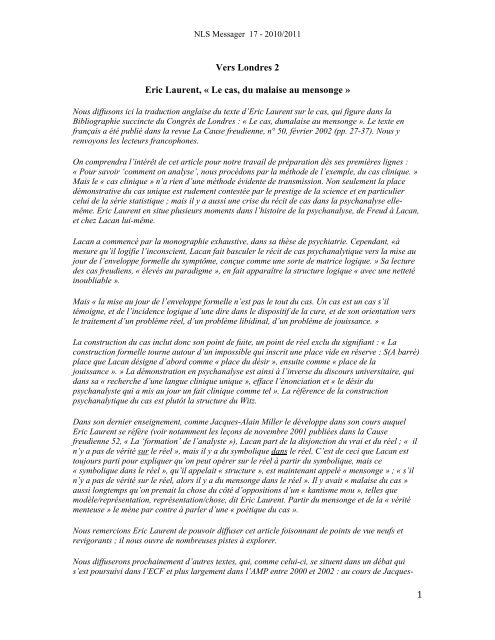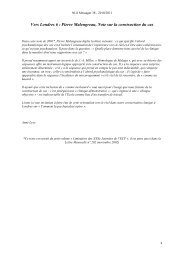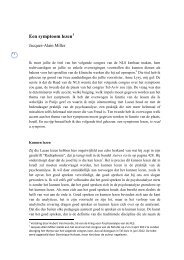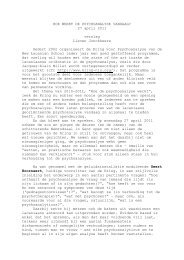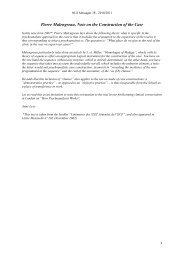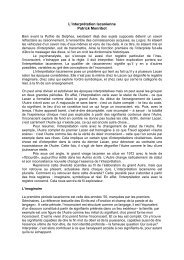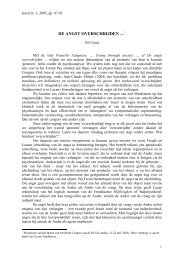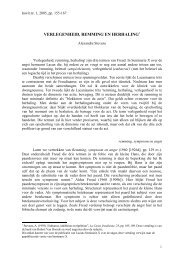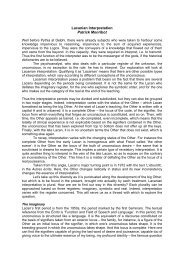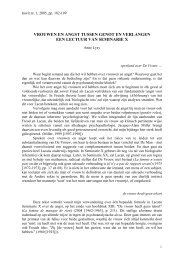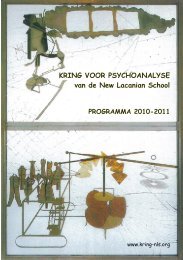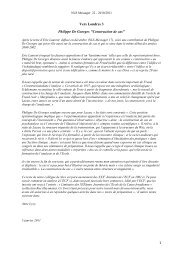Vers Londres 2 Eric Laurent, « Le cas, du - Psychoanalyse Lacan ...
Vers Londres 2 Eric Laurent, « Le cas, du - Psychoanalyse Lacan ...
Vers Londres 2 Eric Laurent, « Le cas, du - Psychoanalyse Lacan ...
Create successful ePaper yourself
Turn your PDF publications into a flip-book with our unique Google optimized e-Paper software.
NLS Messager 17 - 2010/2011<br />
<strong>Vers</strong> <strong>Londres</strong> 2<br />
<strong>Eric</strong> <strong>Laurent</strong>, « <strong>Le</strong> <strong>cas</strong>, <strong>du</strong> malaise au mensonge »<br />
Nous diffusons ici la tra<strong>du</strong>ction anglaise <strong>du</strong> texte d’<strong>Eric</strong> <strong>Laurent</strong> sur le <strong>cas</strong>, qui figure dans la<br />
Bibliographie succincte <strong>du</strong> Congrès de <strong>Londres</strong> : « <strong>Le</strong> <strong>cas</strong>, <strong>du</strong>malaise au mensonge ». <strong>Le</strong> texte en<br />
français a été publié dans la revue La Cause freudienne, n° 50, février 2002 (pp. 27-37). Nous y<br />
renvoyons les lecteurs francophones.<br />
On comprendra l’intérêt de cet article pour notre travail de préparation dès ses premières lignes :<br />
« Pour savoir ‘comment on analyse’, nous procédons par la méthode de l’exemple, <strong>du</strong> <strong>cas</strong> clinique. »<br />
Mais le « <strong>cas</strong> clinique » n’a rien d’une méthode évidente de transmission. Non seulement la place<br />
démonstrative <strong>du</strong> <strong>cas</strong> unique est rudement contestée par le prestige de la science et en particulier<br />
celui de la série statistique ; mais il y a aussi une crise <strong>du</strong> récit de <strong>cas</strong> dans la psychanalyse ellemême.<br />
<strong>Eric</strong> <strong>Laurent</strong> en situe plusieurs moments dans l’histoire de la psychanalyse, de Freud à <strong>Lacan</strong>,<br />
et chez <strong>Lacan</strong> lui-même.<br />
<strong>Lacan</strong> a commencé par la monographie exhaustive, dans sa thèse de psychiatrie. Cependant, «à<br />
mesure qu’il logifie l’inconscient, <strong>Lacan</strong> fait basculer le récit de <strong>cas</strong> psychanalytique vers la mise au<br />
jour de l’enveloppe formelle <strong>du</strong> symptôme, conçue comme une sorte de matrice logique. » Sa lecture<br />
des <strong>cas</strong> freudiens, « élevés au paradigme », en fait apparaître la structure logique « avec une netteté<br />
inoubliable ».<br />
Mais « la mise au jour de l’enveloppe formelle n’est pas le tout <strong>du</strong> <strong>cas</strong>. Un <strong>cas</strong> est un <strong>cas</strong> s’il<br />
témoigne, et de l’incidence logique d’une dire dans le dispositif de la cure, et de son orientation vers<br />
le traitement d’un problème réel, d’un problème libidinal, d’un problème de jouissance. »<br />
La construction <strong>du</strong> <strong>cas</strong> inclut donc son point de fuite, un point de réel exclu <strong>du</strong> signifiant : « La<br />
construction formelle tourne autour d’un impossible qui inscrit une place vide en réserve : S(A barré)<br />
place que <strong>Lacan</strong> désigne d’abord comme « place <strong>du</strong> désir », ensuite comme « place de la<br />
jouissance ». » La démonstration en psychanalyse est ainsi à l’inverse <strong>du</strong> discours universitaire, qui<br />
dans sa « recherche d’une langue clinique unique », efface l’énonciation et « le désir <strong>du</strong><br />
psychanalyste qui a mis au jour un fait clinique comme tel ». La référence de la construction<br />
psychanalytique <strong>du</strong> <strong>cas</strong> est plutôt la structure <strong>du</strong> Witz.<br />
Dans son dernier enseignement, comme Jacques-Alain Miller le développe dans son cours auquel<br />
<strong>Eric</strong> <strong>Laurent</strong> se réfère (voir notamment les leçons de novembre 2001 publiées dans la Cause<br />
freudienne 52, « La ‘formation’ de l’analyste »), <strong>Lacan</strong> part de la disjonction <strong>du</strong> vrai et <strong>du</strong> réel ; « il<br />
n’y a pas de vérité sur le réel », mais il y a <strong>du</strong> symbolique dans le réel. C’est de ceci que <strong>Lacan</strong> est<br />
toujours parti pour expliquer qu’on peut opérer sur le réel à partir <strong>du</strong> symbolique, mais ce<br />
« symbolique dans le réel », qu’il appelait « structure », est maintenant appelé « mensonge » ; « s’il<br />
n’y a pas de vérité sur le réel, alors il y a <strong>du</strong> mensonge dans le réel ». Il y avait « malaise <strong>du</strong> <strong>cas</strong> »<br />
aussi longtemps qu’on prenait la chose <strong>du</strong> côté d’oppositions d’un « kantisme mou », telles que<br />
modèle/représentation, représentation/chose, dit <strong>Eric</strong> <strong>Laurent</strong>. Partir <strong>du</strong> mensonge et de la « vérité<br />
menteuse » le mène par contre à parler d’une « poétique <strong>du</strong> <strong>cas</strong> ».<br />
Nous remercions <strong>Eric</strong> <strong>Laurent</strong> de pouvoir diffuser cet article foisonnant de points de vue neufs et<br />
revigorants ; il nous ouvre de nombreuses pistes à explorer.<br />
Nous diffuserons prochainement d’autres textes, qui, comme celui-ci, se situent dans un débat qui<br />
s’est poursuivi dans l’ECF et plus largement dans l’AMP entre 2000 et 2002 : au cours de Jacques-<br />
1
NLS Messager 17 - 2010/2011<br />
Alain Miller, aux Journées d’automne 2001 de l’ECF « Tu peux savoir comment on analyse à l’Ecole<br />
de la Cause freudienne », jusqu’au Congrès de l’AMP de 2002 sur « les effets-de-formation ».<br />
Dès que le Blog <strong>du</strong> Congrès sera accessible – cela sera annoncé par Dominique Holvoet -, nous<br />
pourrons nous aussi entrer dans le débat !<br />
Anne Lysy,<br />
14 décembre 2010<br />
2
NLS Messager 17 - 2010/2011<br />
The Case, from Unease to the Lie<br />
<strong>Eric</strong> <strong>Laurent</strong><br />
Unease<br />
To know “how one analyses”, we rely on a method that uses examples, clinical <strong>cas</strong>es. This<br />
method is traditional in the discipline. It is not without being criticised. The prestige of science<br />
and statistical series undermines, in human sciences, the lustre of the unique <strong>cas</strong>e. The question<br />
is not limited to psychoanalysis or clinical disciplines. This calling into question of the <strong>cas</strong>e is not<br />
an unbroken process. <strong>Le</strong>t us consider History, for example. We witnessed the Annales School's<br />
fascination for statistical series and its disdain for the singular <strong>cas</strong>e. We now consider that the<br />
most difficult thing there is is to write a description of a great man, of historical contingency,<br />
without renouncing the description of the determinants he or she had to stand up against.<br />
Inscribing the contingency of the <strong>cas</strong>e in necessity is the most delicate thing in what is at stake.<br />
The crisis of the <strong>cas</strong>e study in psychoanalysis, the fact that one no longer knows very well how to<br />
write one up, and the diversity of recognised narrative modes, signal unease. The latter seems<br />
to be organised around a certain number of false oppositions and false dilemmas. <strong>Le</strong>t us cite,<br />
without any particular order, qualitative versus quantitative, vignettes versus extensive <strong>cas</strong>es<br />
and exhaustive monographs, lengthy series versus isolating the relevant variables in a single<br />
<strong>cas</strong>e. Scientists balk at inscribing psychoanalytic <strong>cas</strong>e studies in the framework of the single <strong>cas</strong>e<br />
experiment [TN: English in the original], as certain psychoanalysts want them to do. 1 What, then,<br />
is an experience that depends as closely on the observer/observed link as that which is installed<br />
by transference?<br />
In truth, the problem is the following: psychoanalysis is not an exact science. Mimicking science<br />
outside of its domain only leads to parody. It is often the <strong>cas</strong>e with statistical series in our field.<br />
In this sense the <strong>cas</strong>e cannot be “objective”. This does not at all prevent the psychoanalytic<br />
clinic and its narrations - that is “symptom types” - from existing. Each <strong>cas</strong>e, in its contingency, is<br />
inscribed in existing categories. How is it inscribed? 2 The epistemology of classifications renders<br />
the function of classification as such apparent. It is a nomination, an “indivi<strong>du</strong>ation”. To name<br />
the <strong>cas</strong>e, the demand to speak well, is one of the names of the logic of analytic experience. It<br />
directs what the analysand says [le dire], his transference, and the interpretative speech [dire] of<br />
the analyst.<br />
The Evolution of the Freudian Model<br />
The Freudian <strong>cas</strong>e study initially adopted the form of Goethe’s novels. Dora's suffering owes a<br />
lot, in the way in which it is expressed, to the suffering of the young Werther living through<br />
German idealism. Yet these <strong>cas</strong>e-studies set a model: the dream and its associations, derived<br />
from the original form established by Freud in his Interpretation of Dreams to give an account of<br />
the initial analytic experience. Freud succeeded in giving a narrative form to structure, freed<br />
from the constraints of the ideal. He succeeded in integrating the analytic session –<br />
fundamentally knotted in the dis-symmetry between the analyst and the analysand – into one<br />
1<br />
2<br />
Widlöcher D., «La méthode <strong>du</strong> <strong>cas</strong> unique», <strong>Le</strong> <strong>cas</strong> en controverse, Paris, PUF, 1999, p. 198.<br />
Miller J.-A., La conversation d’Arcachon, Paris, Agalma Seuil, coll. <strong>Le</strong>Paon, 1997, pp. 267-68.<br />
3
NLS Messager 17 - 2010/2011<br />
and the same continuous narrative of the subject's dialogue with his unconscious. He also<br />
succeeded in transmitting his mode of narration to Abraham and Ferenczi. His romantic taste<br />
continued to direct him towards a continuation of the German historical novel, towards the<br />
historical dream, presented more or less explicitly as fiction. The splitting of the novelist and his<br />
fiction is always more or less present. It can be read in Jensen's Gradiva or in the biographies,<br />
turned into novels, of cultural heroes like Mereschkowski's 3 <strong>Le</strong>onardo da Vinci. Karl Abraham<br />
and Otto Rank were very impressed by it. We had to wait for the First World War and the study<br />
on the “Wolf Man” to break with these ancient forms. It was to be the last Freudian “<strong>cas</strong>e” to<br />
take the classic form of the “<strong>cas</strong>e study”.<br />
Literature seized upon the resources of the Freudian <strong>cas</strong>e study in order to extricate itself from<br />
conventional forms. Schnitzler's Traumnovelle, which dates back to 1926, uses Freud to force<br />
literature to say more about the sexual content of a subject's behaviour. It was in 1925 that<br />
Alban Berg wanted to turn Bűchner's Woyzeck – whose drama includes clinical papers and<br />
forensic news items – into an opera. Automatic writing, exquisite corpses, the critical paranoia<br />
method, interior monologue and the continuous stream of thoughts became as many places of<br />
experimentation for the new literature. Tastes changed. This put literature and <strong>cas</strong>e studies in<br />
perspective at the moment when, in psychoanalysis, at the “turning point of the 1920s” - there<br />
was a crisis in the practice of interpretation – and this had an effect on the model of the<br />
narrative of the dream and its associations. The “crisis of interpretation” of the 1920s put the<br />
practice of the <strong>cas</strong>e study in jeopardy. Instead of a triumphant association resulting in the<br />
demise of a symptom, psychoanalysts are faced with a symptom that resists the unveiling of the<br />
unconscious. “Case-studies” come to account for the difficulties of each person as well as for the<br />
extension of psychoanalysis there where dreams do not have the same currency, in psychosis<br />
for example. Far more than for the Freudian model, it is the unit of the psychoanalytic session<br />
which is being recounted. Authors try to make their narratives coincide with their practice. The<br />
dream of a laboratory notebook underlies this extraction of the crucial moments of a session.<br />
The unit of the <strong>cas</strong>e study was no longer the destiny of a given subject, but the memorable and<br />
transmissible fact, extracted from a session. The short form was to prevail. Melanie Klein<br />
invented a new form, the modality of the record of experience, session by session. The<br />
“material”, immediately translated into “unconscious” terms by a contribution of the<br />
psychoanalyst of the same length, turned upside down the way Freudian narratives were<br />
organised. The interest is focused on what we would call “the epiphany” proper to each session,<br />
a manifestation of the unconscious in its materiality and a demonstration of the “savoir faire”<br />
*“know how”+ of the psychoanalyst. She only managed to circumvent the question of publication<br />
difficulties by delaying the publication of her analysis of a 10-year old child (Narrative of a Child<br />
Analysis) until her death (1960). In this way, she maintained the extensive form of the<br />
monograph. It was however to be the last published monograph.<br />
Things would evolve into the clinical vignette, the brief clinical form, at the same time as<br />
literature in the broader sense adopted the Freudian proce<strong>du</strong>res to turn it into a new literary<br />
object. At the same time also as people no longer took responsibility for “psychoanalysis” as<br />
such, but devoted themselves to illustrating only one partial aspect of it.<br />
From History to Logic<br />
3<br />
Published in <strong>Le</strong>ipzig in 1911, it inspired Freud for his study of Limard.<br />
4
NLS Messager 17 - 2010/2011<br />
It is from within this crisis that the evolution of the method chosen by Dr <strong>Lacan</strong>, starting with his<br />
thesis, fully shows its worth. In his thesis in psychiatry, which led him to the threshold of<br />
psychoanalysis, the basis for the method is from Jaspers, and is organised around the concept of<br />
personality, but he turns it round to the French perspective of “concrete psychology” 4 . He<br />
hopes for the publication of exhaustive monographs on a <strong>cas</strong>e *in which there is+: “a dramatic<br />
plenitude of the subject-to-subject relation, at the heart of its objective consequences in<br />
scientific terms; this dramatic plenitude unfolds in a quest that goes beyond the reality of<br />
behaviour, namely to the truth that is constituted in it”. 5 It is a veritable single <strong>cas</strong>e experiment<br />
relying on the unit of the “personality”. <strong>Lacan</strong>'s transition to psychoanalysis has him abandon<br />
the fallacious hopes of an exhaustive method. More exactly, he comes to replace exhaustiveness<br />
with coherence at the formal level at which the symptom is established. We will find again an<br />
echo of this method in the emphasis placed on the role of the recuperation by each subject of<br />
his history. 6 As he logicises the unconscious, <strong>Lacan</strong> takes the psychoanalytic <strong>cas</strong>e study towards<br />
the exposition of the formal envelope of the symptom, conceived as a kind of logical matrix.<br />
In the reading he makes of Freud's <strong>cas</strong>es, <strong>Lacan</strong> “elevates the <strong>cas</strong>e to the paradigm”, to the rank<br />
of “the example that shows” the formal properties, in the broadest sense, of the manifestations<br />
of the Freudian unconscious. The paradigm brings forth structure, and indicates the symptom's<br />
place in a class just as well as the elements of substantiality in a subject's life which recur and<br />
alternate, or again the modes of declension of the repetition of the same. In this way, the logical<br />
and topological structure of the Freudian <strong>cas</strong>es appears with an unforgettable clarity. The logical<br />
structure of the circuits that Little Hans makes around the void of phobia is revealed in the<br />
reading of the <strong>cas</strong>e. Schema R shows the bare bones of Schreber's psychosis, starting from the<br />
signifiers isolated by Freud. The quartet in Dora converges with that of the “Young Homosexual<br />
Woman” by indicating the group of the transformation of feminine sexuality around the signifier<br />
of desire. In the Rat Man, he emphasises the “general combinatory” 7 of the forms of the<br />
obsessional labyrinth.<br />
Bringing to light the unconscious combinatory in each of these paradigmatic <strong>cas</strong>es spared us the<br />
false dilemmas into which the American psychoanalytic movement was able to retreat. <strong>Le</strong>t us<br />
cite a few of them: should we or should we not read Freud's texts as those of a founding father?<br />
Does a veritable science have founders? Do we not waste our time reading the original texts?<br />
This type of question, speciality of Jacob Arlow 8 , supposes that the question of the scientific<br />
status of psychoanalysis be resolved. If it were an exact science, we would no longer have<br />
anything to learn from Freud, everything would have been transmitted in full.<br />
4<br />
<strong>Lacan</strong> J.; De la psychose paranoïaque dans ses rapports avec la personnalité (1932), Paris, Seuil,<br />
1975, p. 346.<br />
5<br />
<strong>Lacan</strong> J.; «Prémisses à tout développement possible de la criminologie» (1950), Autres écrits,<br />
Paris, Seuil, 2001, p. 121.<br />
6<br />
<strong>Lacan</strong> J.; The Function and Field of Speech and Language in Psychoanalysis, Ecrits, tr. B. Fink,<br />
Norton, London 2006, p. 217 «Fonction et champ de la parole et <strong>du</strong> langage» (1953), Écrits. Paris, Seuil,<br />
1966, p. 261.<br />
7<br />
<strong>Lacan</strong> J. The Direction of the Treatment and the Principles of its Power, Ecrits, tr. B. Fink, Norton,<br />
London 2006, p. «La direction de la cure et les principes de son pouvoir», Écrits, op. cit., p. 630.<br />
8<br />
Arlow J.; «Address to the gra<strong>du</strong>ating class of the San Francisco Institute». The American<br />
Psychoanalyst, 25, 15-21. Quoted in Patrick J. Mahony (below).<br />
5
NLS Messager 17 - 2010/2011<br />
These questions come with rhetorical contortions, whereby North American critics must first<br />
consider that Freud was mistaken, that he falsified his results, presented unjustifiable<br />
discrepancies between his session notes and their publication, and con<strong>du</strong>cted himself in a way<br />
that showed base interest in his patients (the aptly named Frink file). In short, you first have to<br />
pull the face of the non-<strong>du</strong>pe for whom there are no great men. It then becomes possible to<br />
recognise that Freud's <strong>cas</strong>es are irreplaceable, and you end up siding with the ironic opinion of<br />
Harold Bloom, the great literary critic: “Freud is one of the most persuasive modern writers” 9 .<br />
Going beyond Freud, rethinking psychoanalysis, bringing to light new concepts to think its<br />
object: all this certainly implies engaging with the dialectic according to which you learn more<br />
from one error of Freud's than from one truth coming from another, as <strong>Lacan</strong>'s “return to<br />
Freud” shows.<br />
How can the particularity of the logical construction of each symptom be inscribed in<br />
classification types? 10 The symptom’s character of logical coherence affirms that classes of<br />
symptoms exist and at the same time it deconstructs them.<br />
Giving Proof<br />
There is more to a <strong>cas</strong>e than bringing the formal envelope to light. A <strong>cas</strong>e is a <strong>cas</strong>e if it bears<br />
witness both to the logical incidence of what is said [le dire] in the mechanism of the cure and to<br />
its orientation towards the treatment of a real problem, a libidinal problem, a problem of<br />
jouissance. If we observe this gravitation of the signifying logic in the field of jouissance, then we<br />
will be able to speak of a <strong>cas</strong>e in the sense in which we rediscover the Latin <strong>cas</strong>us 11 , that which<br />
falls, an unfortunate contingency, or the Freudian Einfall, which covers the same semantic zone.<br />
Further, the subject must also “recognise the part he has played” in this game played logically,<br />
like all great games. This participation is the way in which the subject will have, in return, a hold<br />
on the truths revealed to him in the course of the analysis. He invested his being in it, which<br />
means, for us, his flesh and his drives, from the moment of insertion into the babbling of the<br />
fort-da. The place of this participation, of this “forbidden” *interdite] and not accursed part, is<br />
first named by <strong>Lacan</strong> as the place of desire. 12 Later on it will be the place of jouissance, once he<br />
has revised his theory of the symptom. 13 The formal construction turns around an impossible,<br />
which inscribes an empty place in reserve: S(A).<br />
This place is recognised as crucial, not only for what is at stake in a treatment, but also for the<br />
analytic community. How does the psychoanalytic discourse constitute its community of<br />
listeners and presenters? How do they recognise the evidence submitted to them? Is it by way<br />
of a common language, a common definition of what a <strong>cas</strong>e would be, of what an ideal analysis<br />
9<br />
Mahony RU.; «<strong>Le</strong>s <strong>cas</strong> de Freud aujourd’hui», <strong>Le</strong> <strong>cas</strong> en controverse, Paris, PUF, 1999, p. 130.<br />
10<br />
Miller J.-A.; La conversation d’Arcachon, op. cit., 1997, pp. 267-268.<br />
11<br />
Casus is the noun form of the past participle of cadere and means, strictly speaking, «the fact of<br />
falling, a fall». It is a euphemism to designate death and means «what happens by chance, unfortunate<br />
accident, mishap». Dictionnaire historique de la langue française, sous la direction d’Alain Rey, Paris, <strong>Le</strong><br />
Robert, 1998.<br />
12<br />
<strong>Lacan</strong> J., The Direction of the Treatment and the Principles of its Power, Ecrits, tr. B. Fink, Norton,<br />
London 2006, p. 528 («La direction de la cure…» (1958), Écrits, op. cit., p. 633.)<br />
13<br />
Miller J.-A.; The Seminar of Barcelona jn Psychoanalytical Notebooks 1, p. 52 («Séminaire de<br />
Barcelone sur Die Wege der Symptombil<strong>du</strong>ng», <strong>Le</strong> symptôme-charlatan, Paris, Seuil, 1998, p. 40.)<br />
6
NLS Messager 17 - 2010/2011<br />
would be, with a predictable result? The analytic discourse proceeds inversely. The <strong>cas</strong>e study<br />
includes forms that are regulated in the different psychoanalytic work communities. Models of<br />
the genre circulate. But it is in the gap in relation to these models that the quality of the work of<br />
each analyst, and his or her presence, are felt. A clinical <strong>cas</strong>e is, in this respect too, inscription<br />
and gap. How, then, can the pertinence of the gap be recognised?<br />
The fundamental indication that <strong>Lacan</strong> gave on this point is that demonstration in<br />
psychoanalysis is homogeneous to the form of the witticism. It is starting from the effect of<br />
meaning [sens] rather than from meaning [sens] that <strong>Lacan</strong>, in his last teaching, makes the<br />
signifier and meaning hold together. He is in this way close to Wittgenstein, at least the second<br />
Wittgenstein, and the latter's acute sense of the disjunction between signifier and signified. This<br />
is what Jacques-Alain Miller notes in his lecture entitled “The apparatus in order to<br />
psychoanalyse” 14 : “<strong>Lacan</strong> did not stop at the Name-of-the-Father. It is in the same anchoring<br />
[agrafe] function that he places what he calls the structure of discourse. When we are in a<br />
discourse, signifier and signified balance each other out *…+ comprehension, including the<br />
agreement between signifier and signified, between meaning and the real, is a community<br />
affair. *…+ the veritable meaning of meaning is use [TN: English in the original] rests on a<br />
common practice of language in a given society. This is what he calls “sharing a form of life.” To<br />
understand each other, we have to share a practice and a form of life.”<br />
The mo<strong>du</strong>s ponens, detachment, occurs in our discourse when a libidinal gain is attained. This is<br />
what <strong>Lacan</strong> retained for the experience of the pass, in which each person defends the<br />
demonstration of his own <strong>cas</strong>e. This mechanism in which one tells one’s story, at the end of<br />
analysis, as if it were a good tale, is structured like a witticism. It radicalises the enunciation of<br />
each person. This model for the transmission of psychoanalysis is accepted by certain authors<br />
outside of our orientation. 15<br />
Following its inclination, the university discourse found a solution by, inversely, effacing<br />
enunciation from language. Hence its search, always, for a new language, a neo-language,<br />
cleansed of the traces of the jouissance of the initial enunciations. The search for a unique<br />
clinical language, for a model of a clinical <strong>cas</strong>e that would be the common ground [TN: English in<br />
original], the common foundation that would allow for an exchange between psychoanalysts,<br />
has to do with this attempt. The utopian aim of this language said to be politically correct is that<br />
it would allow for a great con<strong>du</strong>it, as Locke called language, authorising a communication<br />
cleansed of the misunderstandings that hinder it. This utopian aim of the university discourse is<br />
a clinical enterprise, in the sense that it wants to efface the desire of the psychoanalyst who<br />
brought to light a clinical fact as such. It has to do with the same kind of operation that the<br />
linguist Jean-Claude Milner showed in his beautiful book on L'Amour de la Langue 16 . We are no<br />
longer at the time of a master signifier defining correct usage and tracking down the wild forms<br />
of symptomatic inventions in language. We are at the time of a humanitarian ideal of language,<br />
wanting to give it a correct universal usage.<br />
14<br />
Miller J.-A.; Conférence prononcée à Gand en 1997, publiée dans El sintoma charlatan, Paidos,<br />
1998.<br />
15<br />
Fédida R.; «Morphologie <strong>du</strong> <strong>cas</strong> dans la psychanalyse, questions ouvertes», <strong>Le</strong> <strong>cas</strong> en<br />
controverse, Paris, PUF, 1999, p. 43.<br />
16<br />
Milner J.-C.; L’Amour de la langue, Paris, Seuil, 1978.<br />
7
NLS Messager 17 - 2010/2011<br />
The path proper to the psychoanalytic discourse, in the debate on <strong>cas</strong>e studies, resides in the<br />
contrast between the heterogeneous approach and the universal, expurgated language<br />
approach. Far from the expurgated language approach, we need to bring up to date a clinic of<br />
symptoms established on the discovery, by each subject, of what is nameable and what is<br />
unnameable in the use that he himself makes of the language of his community.<br />
From Unease to the Lie of the Case<br />
We suppose, in the <strong>Lacan</strong>ian orientation, another model than that founded on the<br />
model/representation hypothesis. It is this model that is the source of unease for the <strong>cas</strong>e study<br />
everywhere else. The opposition/articulation between the symbolic and the real is thus thought<br />
in woolly Kantian terms, in the opposition between phenomenon/noumenon,<br />
representation/thing and model/hypothesis.<br />
Attending J.-A. Miller's course in the year 2001-2002, two points particularly stood out in my<br />
mind. One is the articulation between science and orthè doxa. The other is the monstration of<br />
the locus of the “lie” in the categories of RSI. He showed us how the category of the “lie”<br />
occupies the place of the structure as point of real in the symbolic, extending his developments<br />
of his “Barcelona Seminar” 17 . The homology between the two places, between orthè doxa and<br />
the lie, is decisive in psychoanalysis in order to separate ourselves from the impasses inherent to<br />
an epistemology of the model. It is a key that is decisive for the place of the <strong>cas</strong>e study as<br />
demonstration in the psychoanalytic discipline.<br />
The formal envelope of the <strong>cas</strong>e cannot be separated from its poetics. The word also designates<br />
the creation effect obtained by the formalisation of the symptom, both on the side of the<br />
analysand and on the side of the psychoanalyst. Poetics in the psychoanalytic discourse comes<br />
to the place of pragmatism in the master discourse. The master discourse recognises “the act of<br />
language” but attempts to re<strong>du</strong>ce it to the relation to the master signifier. Psychoanalytic<br />
poetics implies an act of language which displaces, dislocates the master signifier. It is a poetics<br />
that exceeds the analyst and the analysand. As <strong>Lacan</strong> says, the analyst is a poem rather than a<br />
poet when he accedes to this dimension in language. It is the point at which the orthè doxa –<br />
which leans on the structure in the real – bears witness to the “lie” of the real.<br />
The Case and the “State of the Thing”<br />
At the end of 1918, Gotlob Frege received the manuscript of Ludwig Wittgenstein's Tractatus<br />
logico-philosophicus. On 28 June 1919, he finally acknowledged receipt and commented on it.<br />
He asked him a series of questions: “From the start, I fell upon the expression 'is the <strong>cas</strong>e' and<br />
'fact' and I suspect that ‘is the <strong>cas</strong>e’ and ‘fact’ are identical. 'The world is all that which is the<br />
<strong>cas</strong>e' and 'The world is the set of facts'. Is every fact not the <strong>cas</strong>e and is all that is the <strong>cas</strong>e not a<br />
fact? Is it not the same thing when I say A is a fact, as when I say A is the <strong>cas</strong>e? Why these two<br />
expressions in this <strong>cas</strong>e?... And now a third expression appears: 'What is the <strong>cas</strong>e, a fact, is the<br />
existence of Sachverhalte” 18 . What <strong>Lacan</strong> designates as “a <strong>cas</strong>e” questions another “state of<br />
thing”, perhaps a “state of the Thing”, a Dingverhalt. In his lecture of 5 December 2001, J.-A.<br />
Miller asked a radical question: would not a veritable <strong>cas</strong>e study be that of the AE, displacing in<br />
17<br />
Miller J.-A.; The Seminar of Barcelona, op.cit. p.58 («<strong>Le</strong> Séminaire de Barcelone sur Die Wege der<br />
Symptombil<strong>du</strong>ng», <strong>Le</strong> Symptôme-charlatan, op. cit., p. 52.)<br />
18<br />
Monk R.; Wittgenstein, le devoir de génie, Paris, Odile Jacob, pp. 166-167.<br />
8
NLS Messager 17 - 2010/2011<br />
a decisive fashion the status of the analyst's knowledge? It is from this perspective that I re-read<br />
the “Preface to the English Edition of Seminar XI”. In this text, <strong>Lacan</strong> has a position that is indeed<br />
“radical” with respect to the knowledge of the analyst. He starts from the outside-sense [horssens+:<br />
“When the space of a lapsus no longer carries any meaning (or interpretation), then only<br />
is one sure that one is in the unconscious. One knows. But one has only to be aware of the fact<br />
to find oneself outside it. *…+ All I can do is tell the truth. No, that isn't so – I have missed it.<br />
There is no truth that, in passing through awareness, does not lie” 19 .<br />
When <strong>Lacan</strong> constructs, a little further on, his category of the real, we can say that he does it the<br />
other way round to Wittgenstein’s thesis, which states that “the world is all that is the <strong>cas</strong>e”.<br />
<strong>Lacan</strong> starts from the object and not from the world: “*...+ the only conceivable idea of the<br />
object, that of the object as cause of desire, *is+ of that which is lacking” 20 . So we obtain a lack<br />
and not a “state of fact”. He then defines the real as lack of the lack, as a “cork that is supported<br />
by the term of the impossible”. What <strong>Lacan</strong> then underlines is that the function of this definition<br />
of the real is to secure its antinomy to the true and to verisimilitude. Truth is approached above<br />
all in its dream dimension: “The truth of which the so-called unconscious function dreams”.<br />
Where is knowledge, then? It is defined as “the little knowledge”, in the same way that <strong>Lacan</strong><br />
evoked “the little reality”. He speaks of how “little we know when it comes to the real”. Freud<br />
himself, described as an “indisputable theoretician of the unconscious”, is defined as the one<br />
who “did not know what he was doing”. Theory is one thing, the knowledge of the analyst is<br />
another. They are disjointed.<br />
How can an analyst defined in this way give an account of a <strong>cas</strong>e? We will see with an example<br />
that that does not leave the analyst without recourse. It simply implies that he should be wary<br />
of identifying with the knowledge of the experience – be mindful of letting the supposition of<br />
knowledge operate in the right way.<br />
The Aim of an Analyst<br />
I have chosen to comment on the way in which our colleague Gennie <strong>Le</strong>moine proceeded in her<br />
use of the <strong>cas</strong>e study. I got hold of the recent publication of the collection of thirteen years of<br />
lectures, interventions, seminars and talks in French-speaking Switzerland under the title<br />
L'Entrée dans le temps [Entering Time]. In more ways than one, Gennie <strong>Le</strong>moine's book lends<br />
itself to questioning the status of the <strong>cas</strong>e study in psychoanalysis. Firstly, on account of the<br />
numerous <strong>cas</strong>es that are cited there; the question of the narrative is itself thematised as such.<br />
More profoundly, something of the book is consonant with this questioning of the status of the<br />
<strong>cas</strong>e study in the <strong>Lacan</strong>ian orientation, because Gennie <strong>Le</strong>moine show<strong>cas</strong>es, insistently, the<br />
practice of the treatment as foundation to the diverse theoretical developments that she<br />
engages with: “Little stories form an integral part of analytic doctrine *…+. Each one contains a<br />
lesson to pick out as each person sees fit” 21 . Theory and narrative, this is the entire emphasis of<br />
the book, starting with its first part, whose title is “From little and big stories to mathemes”. This<br />
19<br />
<strong>Lacan</strong> J., ‘Preface to the English edition of Seminar XI’ in The Four Fundamental Concepts of<br />
Psychoanalysis, Tr. A. Sheridan, Penguin, London, 1979 p.xxxix (Autres ecrits, p.571)<br />
20<br />
Ibid., p. xli (Autres ecrits p. 573)<br />
21<br />
<strong>Le</strong>moine-Luccioni E., L’Entrée dans le temps, Lausanne, Ed. Payot Lausanne, 2001, p. 17. This<br />
part draws on an intervention I made <strong>du</strong>ring one of the evenings of the ECF Library dedicated to<br />
presenting this book, and in the presence of the author.<br />
9
NLS Messager 17 - 2010/2011<br />
questioning continues throughout the book.<br />
The moment when the analyst turns the story into a <strong>cas</strong>e is always grasped from a point of<br />
encounter, from an event that is proper to the treatment. It is only from there that the narrative<br />
of the determinants that weave the subject is organised. It is around the encounter that the<br />
book is organised and that it measures up. The author emphasises that the narrative is not<br />
organised around knowledge, it is organised around an encounter: “The analyst does not know,<br />
for the good reason that he is in the position of little a as agent, in its capacity as object cause of<br />
desire. *…+ The false start does not prevent the encounter of the two desires” 22 .<br />
<strong>Le</strong>t us take as an example the first <strong>cas</strong>e presented under the name Aida. This subject comes to<br />
analysis as she is living in a mythical time, a death-bearing time. She had an ancestor: “*...+<br />
beyond the ancestor, the family history had not yet begun: hence the mythical dimension that<br />
this ancestor and his descendants assumed immediately after. *…+ There was nothing left any<br />
more, only death. She held this against the analyst who, for this reason, became a living being<br />
again. *…+ She could at last, in analysis, encounter the other in the real” 23 . It is from this point<br />
that, for the analyst, the <strong>cas</strong>e is overturned – that the subject reconnects with her life.<br />
As far as the <strong>cas</strong>es are concerned, we can right away note their multiplicity and the diversity of<br />
their sources. There are <strong>cas</strong>es from her practice; there are also <strong>cas</strong>es of supervision, or dialysis.<br />
This particular characteristic of easily integrating these two sources – rare in the literature – is<br />
surely linked to the particular destiny of Gennie <strong>Le</strong>moine's supervision with <strong>Lacan</strong>, which she<br />
talks about. There is one psychodrama <strong>cas</strong>e study. We also find the great feminine figures of<br />
literature commented on by <strong>Lacan</strong>: Antigone, Medea, Sygne, and others that are specific to her,<br />
like the couple formed by Colette Thomas and Arthaud.<br />
The form of <strong>cas</strong>es is very varied. We find long narratives like Karine or Sisyphus, or brief<br />
fragments, <strong>cas</strong>es that ‘come as they are’, like L'Androgyne [The Hermaphrodite] or Domina; brief<br />
moments like interpretations or veritable dialogues, like the one with a psychotic subject in a<br />
psychodrama. It really is a series, “a whole series of examples because not one of them is<br />
exemplary; and the series will not be exhaustive, as there are as many treatments as there are<br />
interventions” 24 .<br />
<strong>Le</strong>t us begin by examining the analytic <strong>cas</strong>es since they are examples of method. <strong>Le</strong>t us take the<br />
<strong>cas</strong>e of Karine. She comes to analysis as a woman who lacks nothing. She is heir to a large<br />
fortune, has chosen a man who she supports and with whom she has children. If she comes, it is<br />
because she has met another man who has made her discover a jouissance that was new to her.<br />
She comes so that the analyst can help her choose between the two men: “If you cannot<br />
choose, I said to her, do not choose”.<br />
The analyst is sensitive to the devastation [ravage] that loss provokes in this subject who has<br />
everything, because she lost her mother very early on. “It is Karine who plays the man, that is to<br />
say, the Mother with a capital letter. She has the initiative and the sexual potency *…+ But, she<br />
says, I cannot leave Pierre, everything would crumble. When my first lover left me, I thought I<br />
would die from it. My nanny was extremely scared. I suffer all the time and then I am scared”,<br />
22<br />
23<br />
24<br />
Ibid. p. 35<br />
Ibid., p. 24.<br />
Ibid., p. 189.<br />
10
NLS Messager 17 - 2010/2011<br />
she adds. “At last she suffers.” It is by leaning on this encounter with pain in the treatment,<br />
which she complains about to the analyst, that the latter pushes her interpretation in a decisive<br />
way: “I tell her that she is experiencing now the pain that she did not experience when her<br />
mother died, the pain she experienced after the first separation without knowing which death<br />
she was mourning. I add that she would not be able to spare herself this pain, that it could not<br />
remain unfelt”.<br />
<strong>Le</strong>t us move on to another <strong>cas</strong>e, the one baptised Wonder-girl [TN: English in the original]. She is<br />
a subject who appears closed in on herself for quite other reasons. She is defined as having no<br />
filiation, no continuity and no memory. She is a star lost in her image. The analysis will consist<br />
essentially, by the handling of the transference, in intro<strong>du</strong>cing a loss that is symbolisable by this<br />
subject. It is the encounter with the presence/absence of the analyst that will allow this subject<br />
to exit from the ideal. In the paradoxes of the contradictions between the feminine position and<br />
the maternal position, the analyst does not seek to round off the edges, she confronts these<br />
contradictions and points them out to the subject: “In sexual love and in the love for the child<br />
that she brings into the world, a woman has twice the chances, both painful and fortunate, of<br />
confronting symbolic <strong>cas</strong>tration” 25 . In <strong>cas</strong>es of single mothers, the analyst accentuates the<br />
“terribilitá” of maternal love. About the mother who has her son tell her: “Mummy, you are my<br />
Daddy”, or “Later on I will be a mummy”, she comments that “The child will not, for all that,<br />
become a <strong>cas</strong>e”: “Or, in that <strong>cas</strong>e, we would have to say that any <strong>cas</strong>e bares the structure” 26 .<br />
Concerning that other mother for whom, “her wishing her youngest son – whom she had not<br />
wanted – dead came back in a panic-stricken fear of harming him”, the analyst adds: “<strong>Le</strong>t us say<br />
that at the same time as she kills him, she works herself to death to make him live, for fear that<br />
he may die from it! Now, this hateful and death-bearing love of a mother is not such an<br />
exceptional or rare trait. It is a universal trait” 27 .<br />
This desire to meet head-on what is most singular in the pain of each of these subjects is not<br />
reserved for women. <strong>Le</strong>t us look at the <strong>cas</strong>e of Sisyphus, this “married man and father, who<br />
condemns himself to satisfy his wife in every way without managing to do so. This plan<br />
completely concealed his own desire. The last caprice of his wife had him undertake to build a<br />
house with his own hands. As he works elsewhere to meet the needs of his family, he never<br />
succeeds in finishing the house. He says, “I don't manage to plug the hole; there is always a<br />
stone missing”. It is Sisyphus. Another time, he dreams that he does not manage to climb a<br />
mountain to the top, because the slope becomes steeper and steeper, to the point of becoming<br />
vertical. I still remember the horror felt by the analysand in the dream, a horror he<br />
communicated to me. It was a veritable torture. At last – I am abridging of course because it<br />
required some years to reach the episode that follows – he comes to his session visibly<br />
exhausted: he has to finish, his wife is not content, she is never content. And yet he does<br />
everything she asks. “I comply”, he says. The word is his. On that point he quite simply asks for a<br />
little time off from analysis to finish the house. What is more, he has no more money to pay for<br />
the analysis. Is he going to spend his capital? One's capital, in analysis, is the mother, that is to<br />
say the source of all subsistence. With the source run dry, death occurs; the analyst sees the<br />
trap: the house or the analysis. “I'll expect you at your usual time”, I say. “But I cannot”,<br />
exclaims Sisyphus with dismay. Yet he comes: and sometime afterwards, he begins divorce<br />
25<br />
26<br />
27<br />
Ibid., p. 118.<br />
Ibid., p. 109.<br />
Ibid., p. 108.<br />
11
NLS Messager 17 - 2010/2011<br />
proceedings” 28 . An intervention was made, the analyst concludes. It is again there, the point of<br />
encounter, that organises the <strong>cas</strong>e. We should note the résumé, the way the <strong>cas</strong>e is condensed,<br />
to come to the crucial point in it.<br />
It is not only in analyses but also in supervision sessions or dialyses, as Gennie <strong>Le</strong>moine says,<br />
that the outside-sense [hors sens] encounter in transference is aimed at. It is undoubtedly linked<br />
to the way in which G. <strong>Le</strong>moine confides in us about how she analysed herself in her supervision<br />
with <strong>Lacan</strong>. She relates the subjective effect pro<strong>du</strong>ced <strong>du</strong>ring one of these supervision sessions.<br />
She was very carefully constructing a clinical picture without feeling that she was there. “I was<br />
reflecting my analytic relation like a mirror, a mirror offered to <strong>Lacan</strong>'s gaze for approval. So<br />
there were only mirrors left. It could have gone on. *…+ This picture that I was painting was<br />
therefore organised on a sort of screen *…+ I was hoping for the thunderbolt that would free me<br />
from it. *…+<br />
“-- You must begin to see...”<br />
The sounding of the <strong>Lacan</strong>ian gong was enough to break the mirror. *…+ The cut had broken the<br />
mirror” 29 . Supervision enabled her to break this relation of images. The first example of such an<br />
effect in supervision bore the name without-limit (sans-limite). “The analyst tells me that he<br />
hears the following words recur insistently: without limits. ‘My analysand does not know any<br />
limits’, he says, by way of conclusion *…+ A memory of a dream that this same analyst had told<br />
me then comes back to me, a dream he had not otherwise paid much attention to. Here is the<br />
dream: the analysand finds himself at home, in his own house, with his analyst. They speak for a<br />
long time (my emphasis). Each person in this house has their own bedroom (how about that!).<br />
They speak, that's all. There it is, the without-limit: it is an endless conversation without sexual<br />
resolution, with his analyst finally at his mercy. It is the desire of the analysand for his analyst<br />
that is without limits *…+”.<br />
What is essential, the analyst concludes, is to make desire emerge: “Whose desire? The question<br />
is problematic” 30 .<br />
The analyst makes this encounter with desire into the decisive support of the subject. “The<br />
intervention thus makes a cut and a subjective effect is grasped in it.” 31 Or again: “The<br />
experience has a radical function, there is nothing before; and there is only one sort of<br />
experience and it is the encounter with the Other. It is a traumatic experience that repeats the<br />
traumatism of birth, of the child thrown, expelled into the human world, in which he is a<br />
stranger” 32 . The experience of the encounter has, in this way, the place of a “Name-of-the-<br />
Father” 33 .<br />
In order to enter into the time of the Other, one needs an experience of this order. The <strong>cas</strong>e is<br />
organised around it. One summarises, one focuses, and one goes for the target. It is also an<br />
28<br />
29<br />
30<br />
31<br />
32<br />
33<br />
Ibid., p. 209.<br />
Ibid., p. 196.<br />
Ibid., p. 193.<br />
Ibid., p. 189.<br />
Ibid., p. 231.<br />
Ibid., p. 186.<br />
12
NLS Messager 17 - 2010/2011<br />
entry into the void, an experience of the desert. “Once one is no longer anyone and no longer<br />
has an object, then one is in what <strong>Lacan</strong> calls 'the subjective drama' ” 34 . “The encounter takes<br />
place in a phenomenon of two voids which “screen/overlap/cover each other” *“s'écrantent”+ in<br />
a syncope; in that instant there is no longer anyone. *TN: “s'écranter” is the reflexive form of<br />
“écranter”, used by <strong>Lacan</strong>, with evocations of “faire écran”, meaning “to screen” or “to cover”.+<br />
There is nothing more indivisible, apparently, than coincidence in the same void” 35 . This<br />
experience radicalises the non-rapport. “What woman really loves is God, God the Father. It is<br />
not the man that she has in front of her. And I have developed that in many ways in my texts”.<br />
Intervention as Name-of-the-Father - “a fact of cut” which pro<strong>du</strong>ces a subjective effect – is<br />
without doubt one of the versions of the Name-of-the-Father inasmuch as it amounts, in <strong>Lacan</strong>'s<br />
last teaching, to a tool, a use. If the symbolic in the real has the lie as its name, the encounter<br />
has the form of an outside-sense, from where the lie is a sign for a subject, through an effect<br />
that attains the efficacy of a witticism. One version of the desire of the analyst that corresponds<br />
to this aim would be to go to the encounter of the encounter.<br />
Translated from the French by Michele Julien<br />
This paper was published in “La Cause freudienne”, 50, p. 27-37, February 2002.<br />
34<br />
35<br />
Ibid., p. 130.<br />
Ibid., p. 40<br />
13


